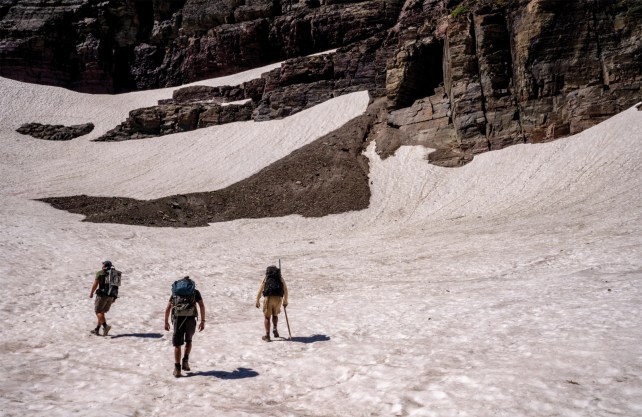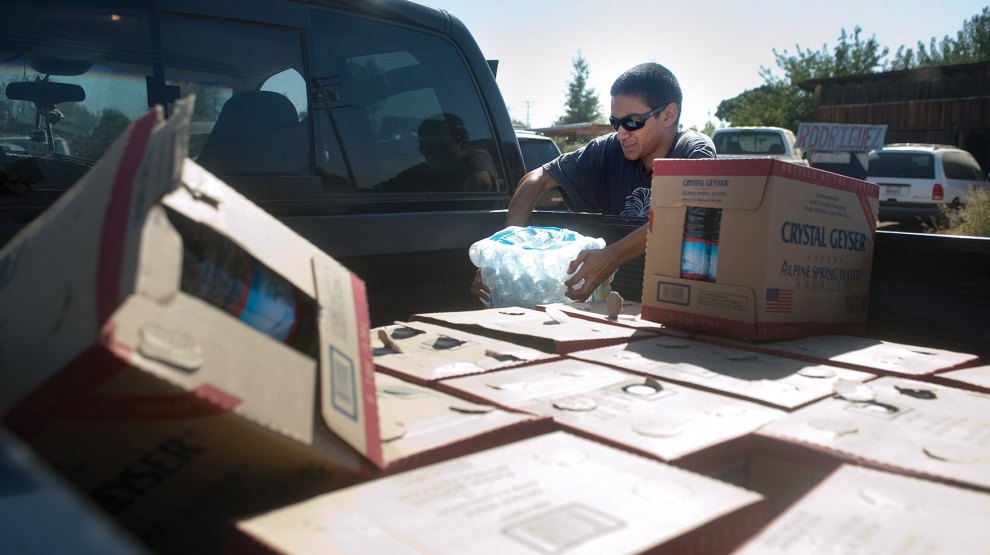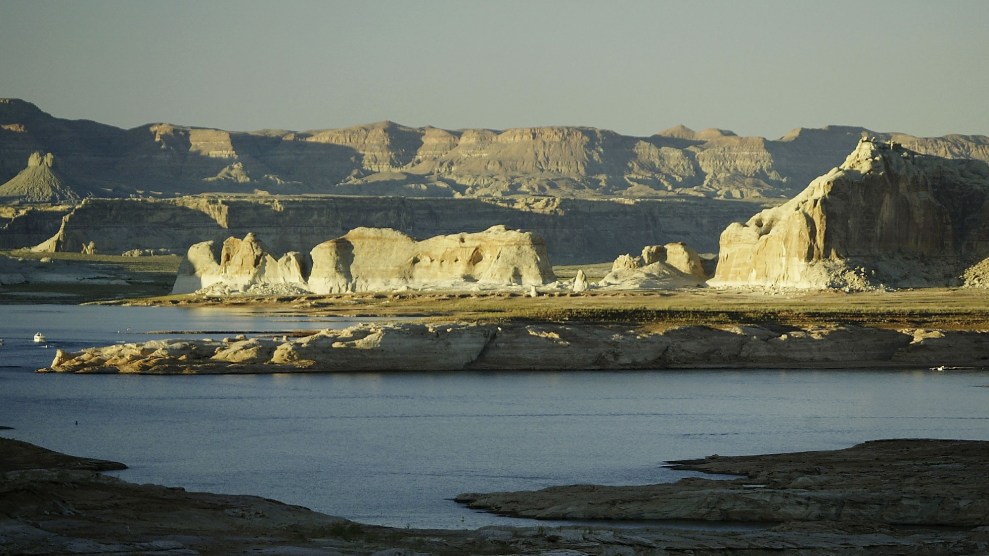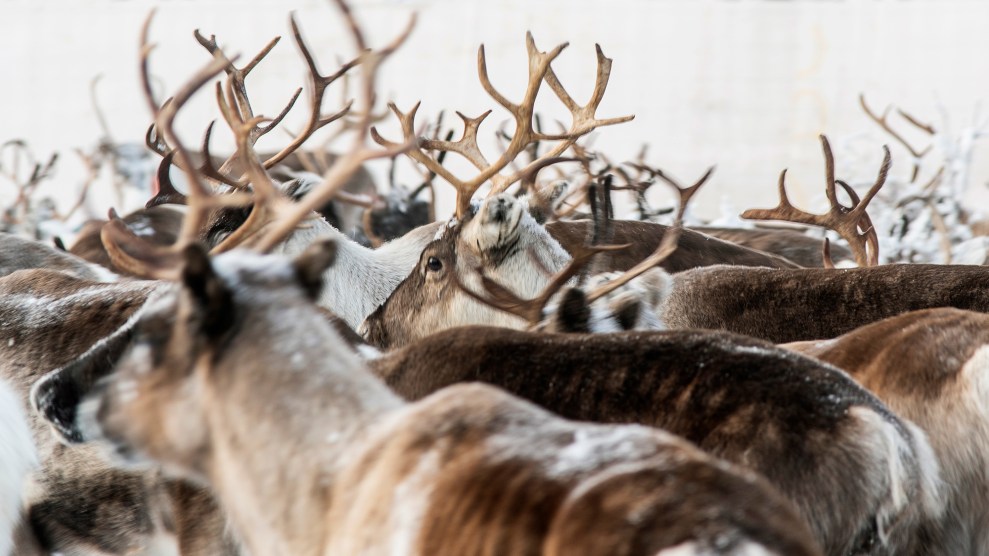
This story was originally published by High Country News and is reproduced here as part of the Climate Desk collaboration.
Jim Elser scanned the snowfields clinging to the lower slopes of Clements Mountain in Montana’s Glacier National Park. While nearby tourists snapped pictures of soaring rock faces and searched for wildlife, Elser, an ecologist at the University of Montana and the director of the Flathead Lake Biological Station, concentrated on just one thing: finding snow algae.
Elser and his research team tramped past flourishing purple asters and yellow arnica wildflowers, gaining elevation until they crested a ridge above a small basin. Marmot chirps replaced the sound of idling car engines at the Logan Pass parking lot, which swarmed with August visitors. A soft hum came from the bulky rectangular device strapped to the back of his colleague, Joe Giersch, an aquatic entomologist at the University of Montana; the device, a light-measuring tool, was warming up in preparation for the scientists’ data collection.
Then, from roughly 100 yards away, the three scientists noticed a faint blush on the slushy snow ahead. They beelined toward it.
Rouge-colored ribbons of algae ran 400 square feet across the sunny slope—Chlamydomonas nivalis, a red-pigmented green algae found in high alpine and polar regions around the globe. The algae’s striking appearance on snow has earned it nicknames ranging from the delicious-sounding—watermelon snow—to the ominous—glacier blood. Scientists believe this algae could play a major role in melting glaciers and snowfields.
Sparkling fresh white snow is the most naturally reflective surface on Earth. When algal blooms take hold, they darken the snow, which then absorbs more heat and melts more quickly. This can create a feedback loop: As temperatures rise and more snow melts, the snow algae—which needs nutrients, light and liquid water—flourishes and expands. The algal bloom alters its own habitat, and appears to alter the surrounding habitat in the process. Just over half of the total runoff in the West comes from snowmelt, but the extent to which snow algae contributes to melting isn’t currently included in standard snowmelt models. These scientists hope that their work can help us better understand the role it plays as the climate changes.
This summer, researchers from around the country crisscrossed the mountains of Washington, Oregon, Wyoming, Utah and Montana, looking for stained snow. They collected samples and tested the reflectiveness of snow algae patches. Sometimes, they stumbled across a site too late and found only pools of blood-red water, where patches of snow and algae had already melted. Finding intact snow to sample became a race against the summer’s heat, and the algae’s growth. “It’s an ephemeral bloom on an ephemeral substrate,” Elser said. “The seasonal snow is going, and whether or not those patches have snow algae on them is also unpredictable.”
The late summer sun beat down on our necks as we examined a patch of snow algae. A third member of Elser’s field team, Pablo Almela Gomez, a postdoctoral researcher at the University of Minnesota, held a long wooden pole. At the end of the pole, the spectroradiometer, a small black tube, dangled over a plot of snow. “This is the nicest algae patch we’ve seen in a while,” Giersch remarked. Only a few pine needles and small pebbles freckled the red splotches.
The scientists used the device to record the snow’s albedo, a measure of what fraction of the sunlight beaming down is reflected back up. Red snow means lower albedo, which means more absorbed sunlight and faster snowmelt. Other factors also influence albedo, including dirt, dust and ash from wildfires. Sand from the Gobi Desert can blow all the way to the Pacific Northwest, while dust from the shrinking Great Salt Lake sometimes coats the Wasatch Mountains. The team also measured the pigment concentration of the snow with a second spectroradiometer to figure out how much of the red color spectrum, most likely from the snow algae, was present.
A bighorn sheep supervised from a jagged cliff high above us as the team worked through the rest of their routine: measuring the water content of the snow, collecting bags of snow samples, and taking a snow core that revealed two layers of algal blooms, including a distinct rusty band a few inches below the surface.
Later that day, in a lab at the University of Montana’s Flathead Lake Biological Station, Elser and Almela Gomez would use the samples to test which inputs help snow algae grow. They’ll melt the snow, mix it together, and add nutrients like nitrogen and phosphorus. Then, after five to 10 days under grow lights in a cold incubator, they’ll measure the chlorophyll levels to see how much the algae grew.
The two types of nutrients come from different places. Previous work suggests that the phosphorus is found in rocks ground up by glacial movement, while nitrogen is blown in from the chemical fertilizers and manure in agricultural areas. The researchers suspect that both types of nutrients encourage algae growth, but they’re particularly interested in nitrogen. They believe algal blooms might be especially common in the Intermountain Rockies due to wind patterns, and they’re hoping to learn more about the dynamics involved.
The team’s work is part of the small but growing field of snow algae research. The scientists hope to figure out what allows snow algae to thrive, and where it’s most likely to live. The Living Snow Project, a citizen science initiative created by Western Washington University researchers, asked skiers, climbers and hikers to help collect pink snow samples. Scientists have also converged on surging algal blooms in the French Alps.
Learning what influences snow algae growth is an important step in understanding a changing water supply. More algae potentially means more melt, and knowing where algae might quicken snowmelt is especially crucial for the drought-prone Western US. Gradual snowmelt is good; it creates a more predictable water supply downstream for reservoirs, and infuses streams with the cold water that fisheries and other aquatic life rely on throughout hot summer months. Rapid snowmelt, however, brings a host of other problems.
Elser compared the snow’s role to ice in a cocktail. “The ice is melting, but your drink is still nice and cold until that last piece of ice goes away,” he said. “Then it’s like, ‘What happened? My drink is warm.’” If snow algae hastens snowmelt or melts all the snow quickly, streams may end up warmer than usual and have less water as the summer advances. “It’s a pretty big deal,” said Scott Hotaling, a member of the snow algae research team and an assistant professor at Utah State University who studies changing mountain ecosystems. “We talk about the whole West being in a drought, and if there’s going to be another factor that perpetuates earlier melt, that’s important.”
Water managers and snowpack surveyors agree that faster melt is an issue, but they don’t necessarily agree on the role snow algae plays. Previous studies suggest that it could be significant: A 2021 article in the journal Nature Communications found that algal blooms were responsible for up to 13 percent of the surface melting that occurs on Greenland’s ice sheet, while a study in Alaska suggests that snow algae accounts for 17 percent of the total melting on one large icefield, a 21 percent increase. “A lot of studies have been done on these big ice sheets, where you have flat surfaces,” said project member Trinity Hamilton, a geomicrobiologist at the University of Minnesota. But mountains, of course, aren’t flat. And researchers don’t yet understand how variations in topography and slope could shape where snow algae grows. The future findings of Hamilton and her team could locate these missing pieces of the puzzle.
“Really knowing how much water is coming from the snowpack and the timing of that is going to be critical for anybody who needs to know about water supply, whether it’s ag producers or for flood control,” said Erin Whorton, a water supply specialist with the Natural Resource Conservation Service’s Idaho Snow Survey. “Snowpack is incredibly important to the way we operate in the West.”
Once snow algae’s effects are better understood, Whorton believes they should be included in models that predict the timing of snowmelt. But not everyone agrees. Is snow algae’s liminal existence in the high alpine a major threat, a pesky annoyance, or something in between? “There are so many variables in snowmelt that one really just needs to stick to the basics of climate variabilities,” said Scott Pattee, a water supply specialist with the NRCS Washington Snow Survey. “It’s really no more concerning than dirty or trashy snow, which can (also) accelerate the melt.”
After the day of fieldwork in Glacier, the men packed up their gear and started slipping and sliding their way back down the snowfield. The Garden Wall rockface unfolded like a postcard in the distance. The snow we had just walked on now ran in rivulets, emptying onto the rocks below. We picked our way through muddy patches of trail and descended past a small waterfall, driven by an underground spring and snow melt. Some portion of the melt, however small, was caused by the living pink bloom we’d visited earlier that day. Time will tell if it will further dry out the already parched West. “The algae are just trying to survive,” Almela Gomez said. “They’re not guilty of anything.”















